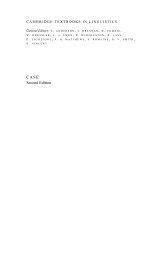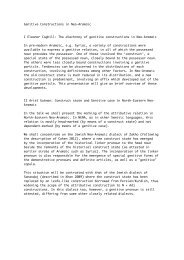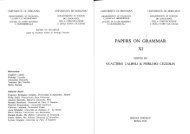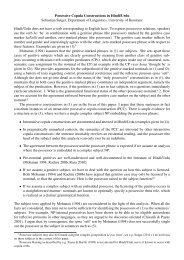Temporal, Causal and Concessive Clauses with the particle wo in ...
Temporal, Causal and Concessive Clauses with the particle wo in ...
Temporal, Causal and Concessive Clauses with the particle wo in ...
You also want an ePaper? Increase the reach of your titles
YUMPU automatically turns print PDFs into web optimized ePapers that Google loves.
6' Hans' runn<strong>in</strong>g has a rapidity (= x) <strong>and</strong> <strong>the</strong> w<strong>in</strong>d has a rapidity (= y),<br />
whereby wie states that x = y<br />
Transferred to a restrictive relative clause <strong>the</strong> paraphrase could be formulated as <strong>in</strong> (7):<br />
7. Des Buech <strong>wo</strong> ich g'lese ha liit uff em Tisch<br />
<strong>the</strong> book PRT I read have lies on <strong>the</strong> table<br />
‚The book that I read lies on <strong>the</strong> table'<br />
ALM<br />
7‘ x is a book <strong>and</strong><br />
7‘‘ I read someth<strong>in</strong>g (=y)<br />
→ Due to <strong>the</strong> <strong>particle</strong>s so or <strong>wo</strong> <strong>the</strong> follow<strong>in</strong>g relation is established: x = y<br />
(see also Br<strong>and</strong>ner, Bräun<strong>in</strong>g, to appear)<br />
There is supposed to be a common structure between equatives <strong>and</strong> restrictive relative clauses<br />
ly<strong>in</strong>g <strong>in</strong> <strong>the</strong> conjunction of t<strong>wo</strong> elements. In (6) it is a conjunction (equation) of properties<br />
whereas <strong>in</strong> (7) <strong>the</strong> conjunction comb<strong>in</strong>es <strong>the</strong> t<strong>wo</strong> elements for which <strong>the</strong> property holds<br />
(compare also Br<strong>and</strong>ner, Bräun<strong>in</strong>g (to appear) for a detailed analysis).<br />
The presentation will discuss <strong>the</strong> follow<strong>in</strong>g open questions: How to analyze <strong>the</strong> occurrence of<br />
<strong>the</strong> <strong>particle</strong> <strong>wo</strong> <strong>in</strong> temporal, concessive <strong>and</strong> causal sentences. What is <strong>the</strong> function of <strong>the</strong> <strong>particle</strong><br />
<strong>in</strong> <strong>the</strong>se structures? How is <strong>the</strong> temporal, causal or concessive read<strong>in</strong>g possible if <strong>the</strong>re is no<br />
St<strong>and</strong>ard German conjunction <strong>and</strong> can we br<strong>in</strong>g toge<strong>the</strong>r <strong>the</strong> analysis for restrictive relative<br />
clauses <strong>with</strong> <strong>the</strong> <strong>particle</strong> structure <strong>in</strong> temporal, causal <strong>and</strong> concessive clauses?<br />
References:<br />
Br<strong>and</strong>ner, Ellen, Bräun<strong>in</strong>g, Iris (to appear). Relative <strong>wo</strong> <strong>in</strong> Alemannic: only a complementizer?<br />
L<strong>in</strong>guistische Berichte.<br />
Bräun<strong>in</strong>g, Iris. 2009. Wo als funktionale Kategorie: e<strong>in</strong>e Studie im Schwäbisch-Alemannischen<br />
Dialekt, MA Thesis. Fachbereich Sprachwissenschaft, Universität Konstanz.<br />
Günthner, Susanne. 2002. Zum kausalen und konzessiven Gebrauch des Konnektors <strong>wo</strong> im<br />
gesprochenen Umgangsdeutsch. Zeitschrift für Germanistische L<strong>in</strong>guistik 30:310-341.<br />
Paul, Hermann. 1920. Deutsche Grammtik IV. Syntax (2. Hälfte). Halle (Saale): Niemeyer.







